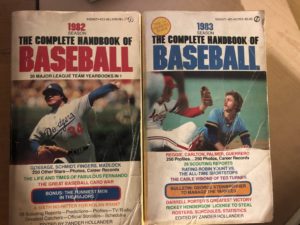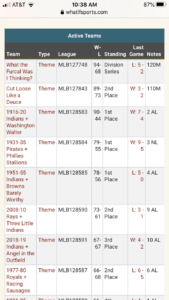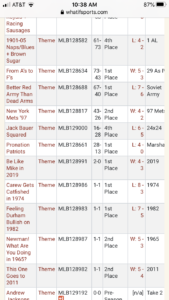Replaying an entire major league season requires several tools, not least of which are time and patience. I started with just the National League for 1982, in part because I was not certain from the outset what would happen. The initial plan was to play a month for each league, alternating back and forth.
Using Statis Pro Baseball, with all the cards provided plus a few I made myself for the limited-use players needed to fill out all the rosters, I followed the league’s actual schedule that I had found in a book I still had from the 1982 season preview the year before. That little paperback The Complete Handbook of Baseball, proved invaluable. The 1983 preview edition had all of the individual statistics from 1982 that I could use.

I collected the books year after year because finding everything you needed in one place was much harder before we’d even dreamed of the internet. The Baseball Encyclopedia was a revelation, of course, putting all of baseball’s historical data into one volume. I bought the updates every few years, because you had to be current. (I still have all of these books. Because of course I do. I have a few posts coming just on baseball books, you can be certain.)
Life in 1983 consisted of more than just simulating baseball games, however. I was in 7th grade at a college preparatory school with hours of homework each night. I had a bar mitzvah in June to prepare for, and I was fortunate to take a trip with my grandparents to Israel and Italy that summer. Plus, you know, pesky things like doing anything else.
This is to say that I did not spend every free moment replaying the 1982 season, but I made progress steadily enough that I became hooked. At that time the National League had 12 teams, each playing 162 games. So that meant 972 games had to be played in all, and each one took over an hour to set up, play, and complete the scoresheet.
After every two weeks’ worth of games, I would compile all the updated season statistics. Though it may seem incomprehensible in our modern computing era while I play online games that do all of it instantly, I had to do all the work by hand initially. I designed special team stat pages and filled them in manually, going through each of my box scores (using the game’s specially designed scoresheets that I could probably recreate from memory right now), adding everything up, and doing all the math.
Once I had my stat updates complete, I would write long letters (on actual paper!) to my sim penpal Caleb and share all the details of my season in progress. He would send me tomes of his own recapping his 1981 adventures. Life got busier for him, too, eventually. He actually could play baseball well and played through high school.
An amazing invention arrived somewhere in the middle of all this: the home computer. I couldn’t afford one until I was about 16 and the mass market developed, but soon I discovered the wonders of a spreadsheet. The program, Lotus 1-2-3, revolutionized my statistical work, though in those days of floppy disks and minimal memory, it could take hours to enter all the data. Saving would take actual minutes, and if anything failed you had to type everything in again.
On average, I could complete about a month’s worth of games in a year. I played all the time in the summer, when I was essentially home alone all day. I’d bring the game with me for visits to grandparents. (I even remember bringing it to a nudist colony my mother belonged to. Yes, there was a nice indoor clubhouse on whose floor I could spread out my game while people outside did whatever it was they did.)
As the years progressed and I stuck with my challenge, the biggest temptation was to move on to a newer season. By the time I reached high school, I was still barely into June of my replay season, and the pace certainly slowed. I attended a very competitive private school, and studying took up nearly all my time. Eventually there were jobs and even a semblance of a social life. Sim baseball basically sat on the shelf outside of vacations in those days.
By the time all the hard work in high school paid off and I headed to Philadelphia to attend the University of Pennsylvania in the fall of 1988, I still was only in early September of my replay season. The game stayed in Los Angeles.
I reached the end of my season in 1990, some seven years after beginning and 10 years after first discovering Statis Pro Baseball. Forget about the American League; this was just to get the NL season done.
Today with an online simulation, you could do it essentially instantly. But where would be the fun in that?











